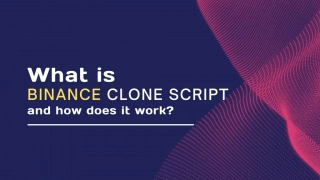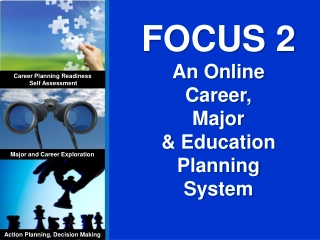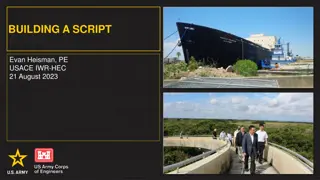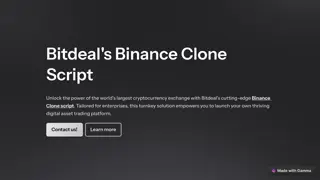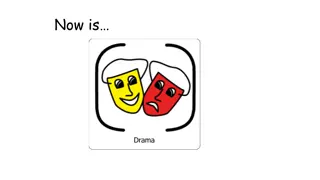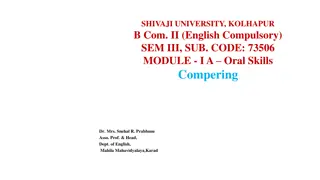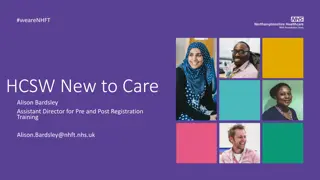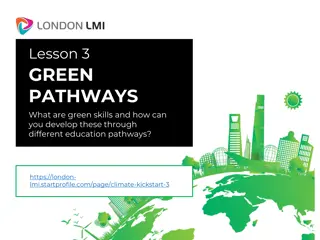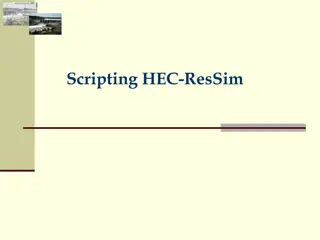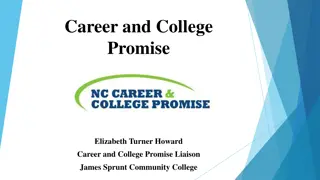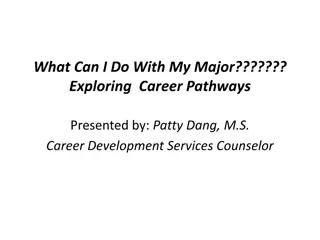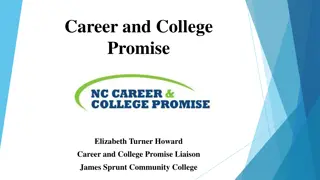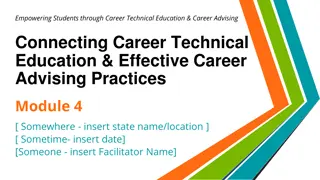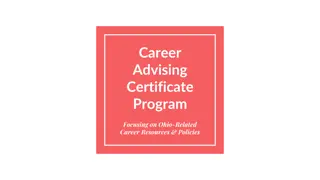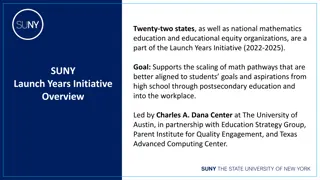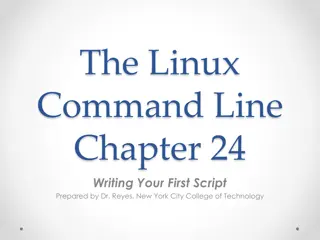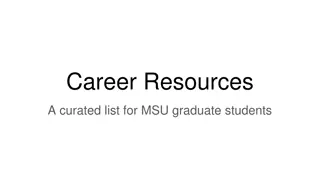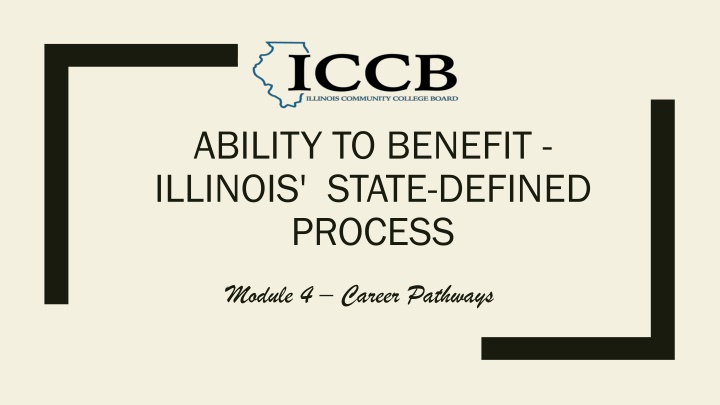
Career Pathways in Illinois for Educational and Career Success
Explore the Illinois state-defined process for Ability to Benefit (ATB) programs, focusing on Career Pathways that align with industry needs. Learn about key elements, allowable career clusters, and education options for achieving success in chosen fields. Discover the significance of Career Clusters, Pathways, and Programs of Study in preparing individuals for higher-skilled positions and obtaining recognized credentials. Gain insights into how Education and Training are organized to accelerate career advancement, promote equity, and ensure continuous improvement for participants.
Download Presentation

Please find below an Image/Link to download the presentation.
The content on the website is provided AS IS for your information and personal use only. It may not be sold, licensed, or shared on other websites without obtaining consent from the author. If you encounter any issues during the download, it is possible that the publisher has removed the file from their server.
You are allowed to download the files provided on this website for personal or commercial use, subject to the condition that they are used lawfully. All files are the property of their respective owners.
The content on the website is provided AS IS for your information and personal use only. It may not be sold, licensed, or shared on other websites without obtaining consent from the author.
E N D
Presentation Transcript
ABILITY TO BENEFIT - ILLINOIS' STATE-DEFINED PROCESS Module 4 Career Pathways
Module 4 Agenda ATB Module Overviews What Is a Career Pathway? Key Elements: Cluster, Pathway, Program of Study Matrix Sample Cluster, Pathway, Program of Study Allowable Career Clusters in Illinois Use with IETs/ICAPS FAQs about ATB and Eligible Career pathways.
Background Module 1 Program Design Student Eligibility Module 2 Required Student Services ATB Module Overviews Success Rate- Accountability Data Collection and Reporting Monitoring Module 3 Corrective Action Termination Clause Eligible Career Pathways Module 4
What Is a Career Pathway? Aligns with the skill needs of industries in the economy of the State or regional economy involved; Prepares an individual to be successful in any of a full range of secondary or postsecondary education options, including apprenticeships registered under the National Apprenticeship Act3. Includes counseling to support an individual in achieving the individual's education and career goals. Includes, as appropriate, education offered concurrently with and in the same context as workforce preparation activities and training for a specific occupation or occupational cluster. Organizes education, training, and other services to meet the particular needs of an individual in a manner that accelerates the educational and career advancement of the individual to the extent practicable. Enables an individual to attain a secondary school diploma or its recognized equivalent, and at least 1 recognized postsecondary credential. Helps an individual enter or advance within a specific occupation or occupational cluster. Commits to equity for all participants and potential participants and continuous improvement IL-Career-Pathways-Dictionary.PDF (isbe.net)
Cluster, Pathway, Program of Study Matrix Career Cluster Career Cluster Career Clusters are occupational categories with industry-validated knowledge and skills statements that define what students need to know and be able to do in order to realize success in a chosen field. Career Pathway Career Pathway Career Pathways outline sequences of academic, career, and technical courses and training that begin as early as ninth grade and lead to progressively higher levels of education and higher-skilled positions in specific industries or occupations. Program of Study Program of Study Programs of Study are non- duplicative progression of courses that align secondary to postsecondary education; and Leads to an industry- recognized credential or certificate at the postsecondary level or an associate or baccalaureate degree. career-clstrs-prgrms-study-fs080528qa-kc.pdf (ed.gov)
Cluster, Pathway, Program of Study Cluster: Manufacturing Pathway: Maintenance, Installation, and Repair o Program of Study: Industrial Maintenance Technology o Program of Study: Industrial Electrician Cluster: Manufacturing Pathway: Production o Program of Study: Mechanical Production Technology o Program of Study: Precision Machine Technology
Allowable Career Clusters in Illinois 1. Agriculture, Food, and Natural Resources 11.Human Services 2. Architecture and Construction 12.Information Technology 3. Arts (Performing and Visual), Audio/Video Technology and Communications 13.Law, Public Safety, Corrections, and Security 14.Manufacturing 4. Business Management and Administration 15.Marketing 5. Education and Training 16.STEM 6. Energy 17.Transportation, Distribution, and Logistics 7. Finance 8. Government and Public Administration Perkins_IV_Crosswalk_Table_1_CIPs_in_Pathwa ys.xls (live.com) 9. Health Sciences 10.Hospitality and Tourism
Use with ICAPS The State-Defined Process is intended to be used along with Integrated Education and Training (IET) programs. These are called ICAPS in Illinois. ICAPS has 3 basic components: 1. Adult Education 2. Workplace Preparation 3. Workforce Training Utilization of ATB can help pay for the Workforce Training component of classroom work in the chosen career pathway.
FREQUENTLY ASKED QUESTIONS ABOUT ATB AND ELIGIBLE CAREER PATHWAYS POSTED: January 15, 2021 AUTHOR: Office of the Postsecondary Education Ability to Benefit Frequently Asked Questions (EA ID: OPE Announcements-21-02) | Knowledge Center
1. Is a student who enrolls in an eligible career pathway program required to complete a secondary school credential? No. But must have the opportunity Students may complete the career pathway without HSE NOTE: The completion of an eligible career pathway program does not enable a student to subsequently become Title IV eligible as a non-ATB degree seeking student unless that student completes the high school diploma portion of the eligible career pathway program or earns an Illinois High School Diploma (HSD). Ability to Benefit Frequently Asked Questions (EA ID: OPE Announcements-21-02) | Knowledge Center
2. How does the Department determine whether a program enables an individual to attain a secondary school diploma or its recognized equivalent? Is the program: Reasonably accessible to enrolled students Distance learning allowable (synchronous/asynchronous) Range of options Convenient for students (reasonable institutional scheduling) Ability to Benefit Frequently Asked Questions (EA ID: OPE Announcements-21-02) | Knowledge Center
3. In what instances will an institutions compliance with the ATB requirements be evaluated in the absence of a career pathway program approval process? Reasonable institutional decisions related to implementing the objectives included within the definition of eligible career pathway programs Whether a program adequately combines rigorous and high-quality education, training, and other services Align with the skill needs of industries in the economy of the State or regional economy involved Institutions must label and identify eligible career pathway programs and disclose to students the limitations of enrolling in such programs, especially for those students who do not enroll in courses designed to enable them to earn a high school diploma or its recognized equivalent. Ability to Benefit Frequently Asked Questions (EA ID: OPE Announcements-21-02) | Knowledge Center
4. What are some examples of how institutions can comply with the requirement to enable an individual to attain a secondary school diploma or its recognized equivalent under Section 484(d)(2)(F)? Adult Education in community Coursework to prepare for diploma/state exam Local/online secondary schools ICAPS Ability to Benefit Frequently Asked Questions (EA ID: OPE Announcements-21-02) | Knowledge Center
Module 4 Summary ATB Module Overviews Career Pathway definition and examples Key Elements: Cluster, Pathway, Program of Study Matrix Allowable Career Clusters in Illinois Use with IETs/ICAPS FAQs about ATB and Eligible Career pathways.
Visit Our Other Modules Module 1: ATB Overview Module 2: State-Defined Process Module 3: Data Collection and Reporting
Resources Important Links Questions? Contact: Whitney Thompson, Deputy Director for Workforce Education, whitney.Thompson@illinois.gov USDOE ATB FAQ CLASP ATB Resources ICCB ATB Resources Angela Gerberding, Director for Work- Based Learning, angela.gerberding@illinois.gov Illinois Letter of Approval, from Dept. of Education

